The wood-burning fireplace insert in my home has a plenum chamber above it, with twin ducts that run vertically, through the mass of the original fireplace, and tie into the hot air return for my HVAC system. The air intake for this plenum chamber is located in the brick facade, several inches above the doors of the insert. When I've had a fire going for a sufficient period of time, depending on how cold it is, the heat in the plenum chamber creates enough of a draw to slowly draw in air and "force" it through the balance of the duct work of the HVAC system. If I manually turn on the blower motor for the propane fueled heater, it takes about 8-10 minutes to normalize temperatures throughout the home. During those times that I keep a good fire going, I use absolutely no propane or electricity, while keeping our house much warmer than we normally would. It is nowhere near as clean or efficient as a rocket mass heater, but it feels great, just the same!
While that is not exactly what you are asking about, it's pretty close. I think the problem with pulling air through the mass of any RHM, and using it to supplement the heat from a conventional forced air system, is that the inherent flaws of a forced air system will quickly cool the mass of the RMH. I hope your experimentation proves me incorrect.







